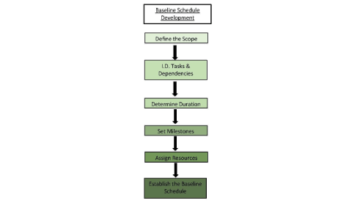The baseline schedule is a critical planning tool for any construction project and is essential to be developed before any actual physical construction begins. It clearly lays out the foundation of the projects preconstruction conditions, construction stages, and is developed to reflect the contractors planned means and methods in which the entire project team (e.g. contractors, subcontractors, owners) can agree upon. In general, the importance of a projects baseline schedule can be seen in two ways. First, it establishes an initial plan for constructing a project and is then used as the basis for measuring a project’s as planned vs. as built historical record. Secondly, the baseline acts as a building block for future project updates as actual construction proceeds. Actual progress can then be used to evaluate performance by reporting on schedule variance – that is actual progress vs. planned progress at a specific point in time.
Without a baseline schedule, it would be impossible to evaluate, track, and mitigate unanticipated events and changes to the project plan. Actively managing your baseline schedule also helps avoid common project planning pitfalls such as late completion, out of sequence work, and even legal claims. Developing a baseline schedule is important for evaluating and tracking the projects progress and to help plan for avoiding future problems.
Define the Project Scope
Before you start developing your schedule, define the scope and create the work breakdown structure. Defining the scope, sounds simple enough but nonetheless is an important stage in creating a schedule. Often the scopes of work can get complicated especially on larger projects where many subcontractors who each have their own individual scopes and goals are involved. Ensure that the project goals are clearly outlined and can be properly presented to all parties involved in the project by utilizing the project schedule.
Identify Tasks and Dependencies
Using your work breakdown structure, use historical data to understand how to define tasks. Brainstorm ideas with your team and stakeholders while you discuss your work breakdown structure with them. This will help ensure you don’t miss any important tasks when building your schedule. Keep in mind that all tasks depend on each other. In a multi-project environment, there can be multiple complex task dependencies. Do not overlook any dependency when creating your schedule.
Identify Tasks and Dependencies
Using your work breakdown structure, use historical data to understand how to define tasks. Brainstorm ideas with your team and stakeholders while you discuss your work breakdown structure with them. This will help ensure you don’t miss any important tasks when building your schedule. Keep in mind that all tasks depend on each other. In a multi-project environment, there can be multiple complex task dependencies. Do not overlook any dependency when creating your schedule.
Determine Duration
Once you have defined all your activities, you will need to estimate how long they’ll take to complete and ensure that you are meeting any contractual timeline obligations. One of the most popular estimation techniques is analogous estimating which involves creating an estimate on the basis of the time it took to complete similar past projects and project activities.
Set Milestones
Milestones are important points throughout the project life cycle. You can use a project milestone to demonstrate an important achievement or completion of an important phase. Consider including contingencies to ensure enough time has been allocated to meet critical milestones, so your project does not fall behind schedule in case you encounter an unexpected project roadblock.
Assign Resources
Assign people to tasks based on their core competencies. Be sure to take into account planned leaves, national holidays, and weather sensitive activities. Identify and assign materials and tools required for task completion.
Establish a Baseline Schedule
Once you have a project schedule, send it to the stakeholders for approval. Some organizations establish a committee for their projects, while others set up multiple committees.
Whatever the model your organization uses, adhere to the approval requirements of your project and document the approval in the prescribed manner. After project stakeholders approve the baseline, leave it alone and if modifications are necessary you will need to re-submit it for approval.
Need help with CPM scheduling in California? The Swaney Corporation-Crowe Construction Inc has you covered. We are committed to helping everyone involved to identify the best way to complete projects. Our ability to help project owners, contractors, subcontractors, and anyone who need assistance in reducing project costs without compromising on quality sets us apart. To learn more, call (707) 665-9668.


